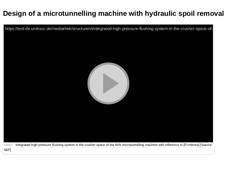
|
(Video: Integrated high-pressure flushing system in the crusher space of the AVN microtunnelling machine) |
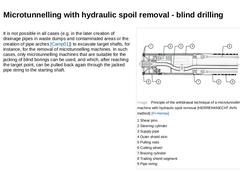
|
It is not possible in all cases (e.g. in the later creation of drainage pipes in waste dumps and contaminated areas or the creation of pipe arches [Camp01]) to excavate target shafts, for instance, for the removal of microtunnelling machines. In such cases, only microtunnelling machines that are suitable for the jacking of blind borings can be used, and which, after reaching the target point, can be pulled back again through the jacked pipe string … |
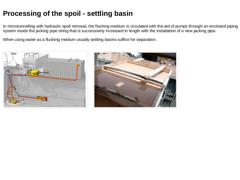
|

In microtunnelling with hydraulic spoil removal, the flushing medium is circulated with the aid of pumps through an enclosed piping system inside the jacking pipe string that is successively increased in length with the installation of a new jacking pipe. When using water as a flushing medium usually settling basins suffice for separation. (Image: Fluid circulation of microtunnelling by means of hydraulic spoil removal) (Image: Settling basin to separate … |
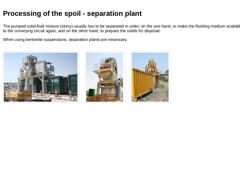
|

The pumped solid-fluid mixture (slurry) usually has to be separated in order, on the one hand, to make the flushing medium available to the conveying circuit again, and on the other hand, to prepare the solids for disposal. When using bentonite suspensions, separation plants are necessary. (Image: Separation plant) (Image: Separation plant) (Image: Separation plant with settling basin) |
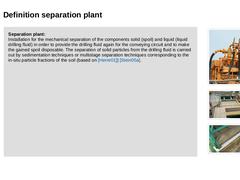
|
|
Separation plant:
Installation for the mechanical separation of the components solid (spoil) and liquid (liquid drilling fluid) in order to provide the drilling fluid again for the conveying circuit and to make the gained spoil disposable. The separation of solid particles from the drilling fluid is carried out by sedimentation techniques or multistage separation techniques corresponding to the in-situ particle fractions of the soil (based on [Herre01]) [… |
|
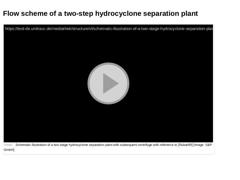
|
(Video: Schematic illustration of a two-stage hydrocyclone separation plant with subsequent centrifuge) |
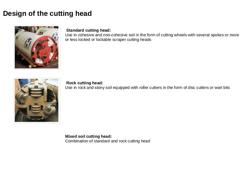
|

(Image: Microtunnelling machine with hydraulic spoil removal - Standard cutting head in the form of cutting wheels [FI-Herreb]) Standard cutting head:
Use in cohesive and non-cohesive soil in the form of cutting wheels with several spokes or more or less locked or lockable scraper cutting heads (Image: Microtunnelling machine with hydraulic spoil removal -Rock cutting head with disc cutters [FI-Herreb]) Rock cutting head:
Use in rock and stony soil … |
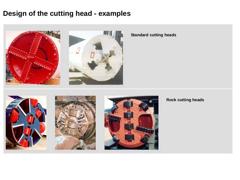
|

|
(Image: Microtunnelling machine with hydraulic spoil removal - Standard cutting head in the form of cutting wheels [FI-Wirthb]) |
(Image: Cutting head design for use in soil and rock - Scraper cutting head with fixed soil entry openings [FI-ICH]) |
Standard cutting heads |
|
(Image: Cutting head design for use in soil and rock - Rock cutting head with (tungsten carbid) insert roller cutters [FI-Wirthb]) |
(Image: Cutting head design for use in soil and … |
|
|

|
Most of the microtunnelling machines using the principle of soil removal are equipped with a crusher in order to expand the limits of applicability to soils of the additional classes S according to DIN 183191 and to rock with a high degree of discontinuities. These are so designed that cobbles, boulders and pieces of rock up to a maximum size of around dmax = 1/3 of the external diameter of the cutting head can be crushed to a particle size which … |
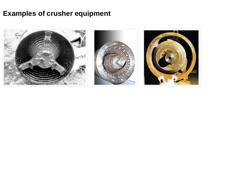
|

(Image: Stone crusher arrangement of the UNCLEMOLE [FI-Isekib]) (Image: Eccentric cone crusher [FI-MGF]) (Image: Pipe-Replacer [FI-NLW] - Eccentric breaker disc; the coned breaker disc is placed eccentrically on the main drive shaft) |
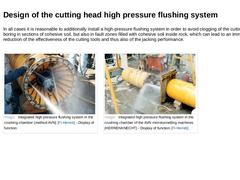
|
In all cases it is reasonable to additionally install a high-pressure flushing system in order to avoid clogging of the cutting tools during boring in sections of cohesive soil, but also in fault zones filled with cohesive soil inside rock, which can lead to an immense reduction of the effectiveness of the cutting tools and thus also of the jacking performance. (Image: Integrated high pressure flushing system in the crushing chamber (method AVN) [… |
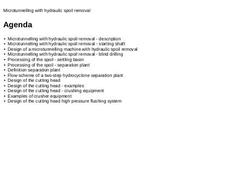
|

|
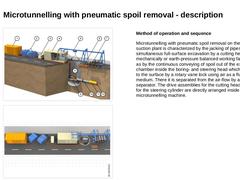
|
(Image: Microtunnelling with pneumatic spoil removal) (Image: Equipment, possible arrangement of the components on the construction site and space requirements (approximately L x W = 34 x 4 m) in microtunnelling with pneumatic spoil removal - plan view (on the model of the jacking of pipes DN/ID 600, pipe length 2.0 m)) Method of operation and sequence Microtunnelling with pneumatic spoil removal on the basis of a suction plant is characterized by the … |
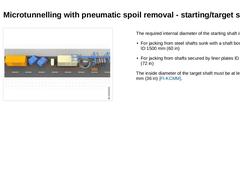
|
(Image: Equipment, possible arrangement of the components on the construction site and space requirements (approximately L x W = 34 x 4 m) in microtunnelling with pneumatic spoil removal - plan view (on the model of the jacking of pipes DN/ID 600, pipe length 2.0 m)) The required internal diameter of the starting shaft is: |
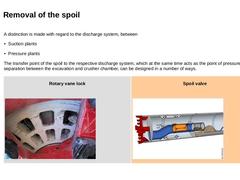
|
|
A distinction is made with regard to the discharge system, between -
Suction plants
-
Pressure plants
The transfer point of the spoil to the respective discharge system, which at the same time acts as the point of pressure-tight separation between the excavation and crusher chamber, can be designed in a number of ways. |
|
Rotary vane lock (Image: HERRENKNECHT AVP method - View of the rotary vane lock behind the excavation chamber [FI-Herreb]) |
Spoil valve |
|
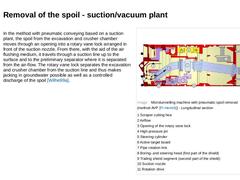
|
In the method with pneumatic conveying based on a suction plant, the spoil from the excavation and crusher chamber moves through an opening into a rotary vane lock arranged in front of the suction nozzle. From there, with the aid of the air flushing medium, it travels through a suction line up to the surface and to the preliminary separator where it is separated from the air-flow. The rotary vane lock separates the excavation and crusher chamber … |
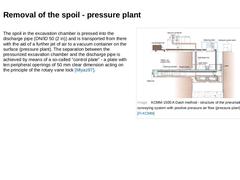
|
The spoil in the excavation chamber is pressed into the discharge pipe (DN/ID 50 (2 in)) and is transported from there with the aid of a further jet of air to a vacuum container on the surface (pressure plant). The separation between the pressurized excavation chamber and the discharge pipe is achieved by means of a so-called "control plate" - a plate with ten peripheral openings of 50 mm clear dimension acting on the principle of the rotary vane … |
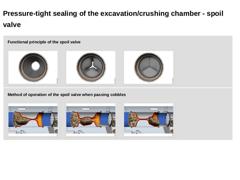
|

|
Functional principle of the spoil valve |
(Image: Method of operation of the valve with reference to [Sakai97] [Image: S&P GmbH] - Valve open) |
(Image: Method of operation of the valve with reference to [Sakai97] [Image: S&P GmbH] - Valve closing) |
(Image: Method of operation of the valve with reference to [Sakai97] [Image: S&P GmbH] - Valve closed) |
|
|
Method of operation of the spoil valve when passing cobbles |
(Image: Method of operation of the valve … |
|
|
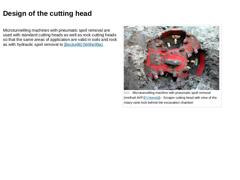
|

Microtunnelling machines with pneumatic spoil removal are used with standard cutting heads as well as rock cutting heads so that the same areas of application are valid in soils and rock as with hydraulic spoil removal to [Becke96] [Wilhe99a]. (Image: Microtunnelling machine with pneumatic spoil removal (method AVP [FI-Herreb]) - Scraper cutting head with view of the rotary vane lock behind the excavation chamber) |
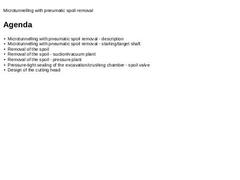
|

|
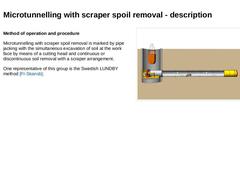
|
Method of operation and procedure Microtunnelling with scraper spoil removal is marked by pipe jacking with the simultaneous excavation of soil at the work face by means of a cutting head and continuous or discontinuous soil removal with a scraper arrangement. One representative of this group is the Swedish LUNDBY method [FI-Skansb]. (Image: Microtunnelling with spoil removal by other mechanical means (spoil removal by a scraper arrangement)) |
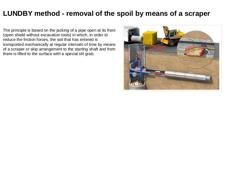
|

The principle is based on the jacking of a pipe open at its front (open shield without excavation tools) in which, in order to reduce the friction forces, the soil that has entered is transported mechanically at regular intervals of time by means of a scraper or skip arrangement to the starting shaft and from there is lifted to the surface with a special slit grab. (Image: Principle of the LUNDBY method with spoil removal by a scraper arrangement … |

|

|
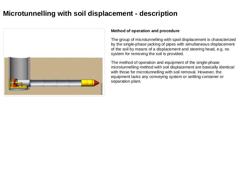
|

|
(Image: Microtunnelling with soil displacement) |
Method of operation and procedure
The group of microtunnelling with spoil displacement is characterized by the single-phase jacking of pipes with simultaneous displacement of the soil by means of a displacement and steering head, e.g. no system for removing the soil is provided.
The method of operation and equipment of the single-phase microtunnelling method with soil displacement are basically identical … |
|
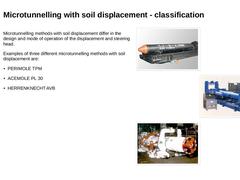
|
Microtunnelling methods with soil displacement differ in the design and mode of operation of the displacement and steering head. Examples of three different microtunnelling methods with soil displacement are: -
PERIMOLE TPM
-
ACEMOLE PL 30
-
HERRENKNECHT AVB
(Image: PERIMOLE TPM 200 method for jacking pipes DN/ID 200 [FI-Isekib] - View) (Image: ACEMOLE PL 30 [FI-NTTb]) (Image: HERRENKNECHT AVB microtunnelling method with soil displacement [FI-Herreb]) |